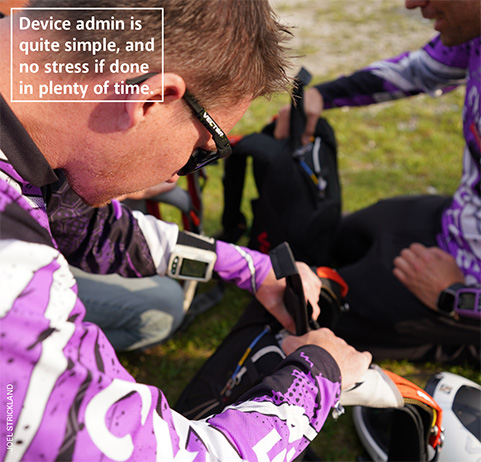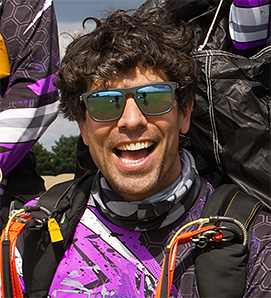Above: Photo by Joel Strickland.
We have the good folk of Norway to thank for the term “innhopp,” which most around the world use to describe the act of riding an aircraft away from a drop zone and parachuting into somewhere else. This is a pretty good result, especially if you are old enough to remember when Americans tried to call parkour “urban ninja” or young enough to wonder why British Skydiving insists on the term “display jump” even when nobody is watching.
Jumping onto a beach or into a field next to a nice restaurant or down at the bottom of a sweet mountain line can produce some hugely exciting and memorable skydiving experiences and easily make the time and effort required to set it all up worthwhile. However, there are many moving parts—crucial variables that everyone involved needs to properly consider.
Expectation vs. Reality
Facilitating an innhopp—which is usually part of a boogie—requires a lot of extracurricular effort from all of the people working at the drop zone. This begins long before the event itself, with potentially a lot of paperwork, politics and regulatory requirements to address with the local aviation authority. Regulations, permits and air-traffic control requirements may vary wildly depending in which country you are in, but the organizers are responsible for ensuring all requirements are met.
When the time comes, everyone with formal responsibility will likely be doing their bit on top of an already fully stacked workday. In all probability, manifest will have been putting up with your nonsense since early in the morning, the coaches have been working with two groups all day (plus front and center in the bar the night before) and the pilots have been hot-fueling from sunrise and eating their lunch in the aircraft. Everybody will be tired, including you, because ... boogie. Wheels up for the jump means being a huge step closer to success and all the work paying off—and the results can be huge—but until then it will be anything from a bit frantic to absolute chaos.
Agency
Signing up for an innhopp means handing over more of your personal autonomy than normal plus turning up the volume on every risk factor. A drop zone is a standing situation for skydiving, with spaces to land and pack and safely put your gear. An innhopp is the opposite, so everything needs to be jigsawed into place. It can be done smoothly, and nobody wants this more than those in charge, but it is smart to always anticipate dealing with an issue or two. Your event staff should be aiming to offer solutions to everyone’s basic requirements, but remember that you are in their hands for something that could be as far out of their comfort zone as it is yours.
Consider This: Jumping into a secret location that the event won’t release details of beforehand adds another sprinkle of adventure to an innhopp. It does, however, further extend every associated risk, so approach it accordingly. Know what you are getting into, and prepare for both the good version and the bad. Don’t forget what you need for the party, but also for when it is getting chilly, where there is nowhere to buy food, when you have zero phone signal and it is too far to walk home.
Task Loading
We have space in our brains for only so much at one time. One can get better with practice and experience, but there is always a very real upper limit to how much information someone can process. Innhopps have a lot going on, so here more than ever the good-sense rules of skydiving apply. Fly within your skillset, pull high and enjoy the scenery. Stay off your wonky side. Less is more and slow is fast. Well-run operations might impose some rules and oversight—such as group sizes or no tracking and such—but just as likely you are completely on your own to get it right.
Risk Management
Skydiving always contains a basic level of danger, but the rewards are good enough that we pursue it by learning to assess and properly manage risk from the very beginning. The drop zone is a controlled environment. Away from there, anything can happen, and during an innhopp these factors spill over the edges of the jump itself. You might be fine with the landing area but what about when there are big trees at both ends, powerlines down one side and five loads of skydivers in there packing, drinking beer and watching you? Are you sure your gear went into the van? Do you need early access to the hangar in the morning because of your flight home? Take time to think it through. One of our oldest sayings is that a skydive is not over until everyone is back in th e hangar. For a normal jump, this is like 30 minutes. An innhopp, all told, can be much, much longer.
e hangar. For a normal jump, this is like 30 minutes. An innhopp, all told, can be much, much longer.
Dress for the Rescue
Skydiving into a party wearing shiny pants and your best disco blazer is an exquisite privilege, and when it goes off it is magical. But how ready are you to answer very serious questions from the crew chief of a coast guard helicopter while dressed as Elsa from Frozen? The operation should have an emergency plan, and probably will, yet there are plenty of places where help is far, far away. As a participant, serious aid is not your responsibility, but if you can hand a lip balm to someone who has been stuck in a tree for 90 minutes with two broken ribs, they will bake you a cake on your birthday every year until the end of time. Remember: Body glitter has no effect on an open head wound. One version of your decisions may light you up at the party, the other might make you popular in the office tomorrow because you aced it when things went sideways. Choose wisely.
Consider This: Jumping barefoot does indeed feel lovely on your toes, plus special and fancy because it’s likely you are aiming for a nice beach, but even if you are perfectly happy to personally accept the additional chance of injury from a piece of coral or an old beer can maliciously hiding in that lovely sand, are you also prepared for how it will feel to be able to offer absolutely zero help to someone else who did find trouble—who maybe crashed a hundred meters back in the woods—and you ain’t got no shoes?
Admin
Feeling ready means being completely on top of all your own affairs. The only way to be sure about what is really in the landing area is to go and walk it out yourself, so go look if you can. Do as much of your own research as possible; whip out all the tools available to know the terrain, weather conditions and local infrastructure. Help with the admin. Does your group of friends have vehicles? Maybe ferry one down there beforehand. If the jump requires your AAD to be offset for the landing-site elevation, there is no need to wait until eight minutes before boarding the plane.
If you have time, do these steps early. Then you can help the people who are still up in the air or under packing pressure get ready, and perhaps the load organizer can eat an apple or something so they don’t pass out. Be ready to go early if things get moved around (possible), and be prepared for the hangry wait (much more likely). If you can produce a bag of Haribo while everyone is sitting on the grass in their gear waiting to maybe or maybe not go, they will probably buy you drinks later.
- No matter what anyone tells you about the vehicle logistics, the only way you can guarantee something will be in the landing area is to jump in with it. It is important to believe this.
- You may or may not be able to pack when you land. If you can, do so. It makes things easier later on. Don’t forget to bring bungees and pull-up cords ... for you and the dummy next to you who didn’t.
- If you cannot pack, a proper stash bag is a strong investment. BASE/freeflight stash bags are designed to be jumped/flown, will offer some protection for equipment in transit, and they look externally like they hold fancy gear that needs to be treated properly (and not squashed at the dump because it was in a trash bag). No cap, fam.
- A lightweight, weatherproof jacket will fit under your swanky event jersey, in a bum bag or minimal backpack under your rig and makes a very real difference if the weather turns on you.
- Some paper money weighs nothing, and when you need it, you really need it. It is impossible to know if you might have to grease the wheels with an angry farmer, pay a local to drive you back or buy dinner for every member of a volunteer mountain rescue team.
- Never go without the appropriate number to call for help and the means to do so if something goes wrong. A photo of the ground crew contact details on a phone that is stuffed down your underpants is not ideal when you are dangling upside down on the side of a cliff. Be certain your device works and has battery life, input the number properly so you can voice activate it, and have it where you can easily reach (a little pouch with a lanyard is excellent).
- Do you have both personal liability and medical insurance that covers skydiving? Have this. Do you understand what it will and will not pay out for? Know this.
- Trust your instincts. If you feel under too much pressure or are getting the danger tingle, maybe don’t go. The forces enticing you to jump anyway can be really strong, but if the fun is fading fast then think about your priorities.
Participating in a smoothly run innhopp might make a lot of the above seem melodramatic. Try a few and get back to me. These jumps can be absolute highlights of your skydiving adventures, and everyone wants them to go well. In practice, expect a mixed bag. The biggest, fanciest gatherings can serve up a total shambles, and the little place giving it a college try can smash it beyond measure. It is the organizers’ job to deliver a carefully considered and well-managed product, but there are many things to get right under (at times) huge pressure. The way to ensure the best possible version is by being on top of your own admin to the point where not only are you not adding pressure on all of the people with formal responsibilities, you are actually in a position to relieve some. Then, with everyone’s ducks in a row, whack some glitter on your face, and let’s go ... because it is party night.
 About the Author
About the Author
Joel Strickland, D-37056, is a professional skydiver who works primarily with Airtec CYPRES and Larsen & Brusgaard Altimeters. He also receives support from Cookie Helmets, Deem Flywear, Performance Designs and United Parachute Technologies.